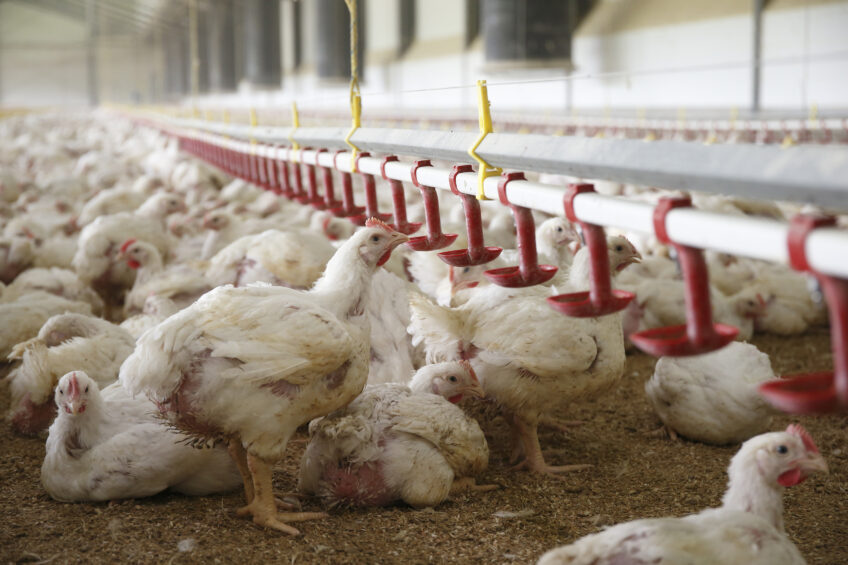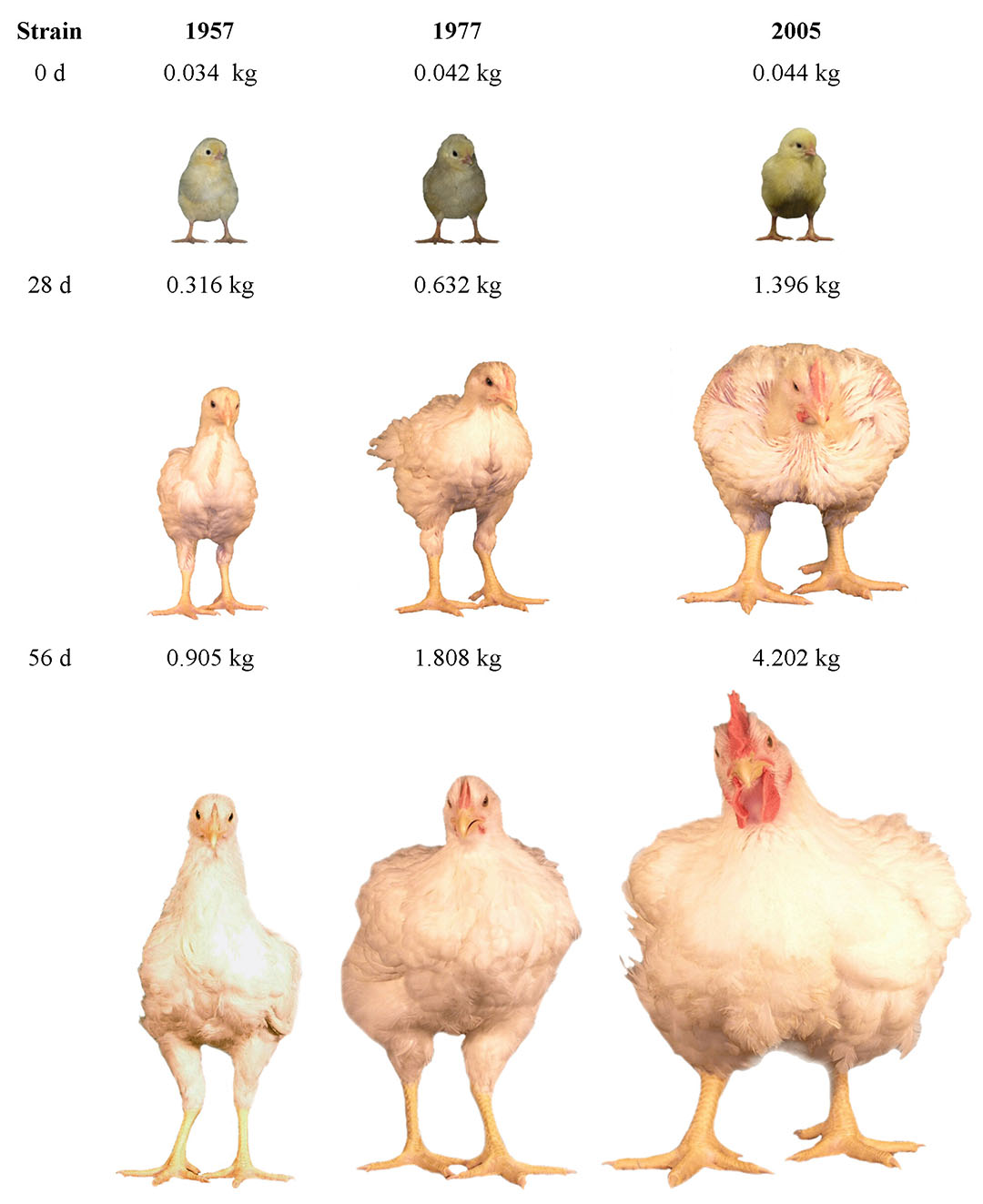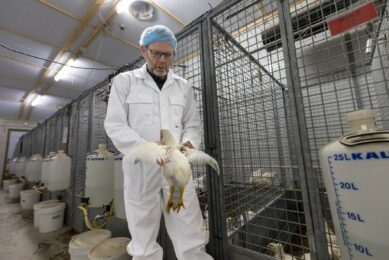Efficient birds needs less land and water

The efficiency of conventional broilers has increased significantly over the last 70 years. Calculations show that for global poultry meat production, land use could decrease by more than 600,000 hectares per year, while consumption remains the same. In addition, annual water consumption can be reduced by more than 5 million cubic metres.
The poultry meat chain consists of 6 successive specialised links: breeding organisations, growers, propagators, hatcheries, broiler farmers and slaughterhouses. Two breeding organisations are currently active in the Netherlands: Aviagen and Cobb. Some 60 growers supply 4.6 million parent animals to approximately 180 breeders each year. These companies produce a total of 900 million hatching eggs annually, which are hatched in 15 hatcheries. 300 million hatching eggs and 150 million day-old chicks are exported. In addition, hatcheries supply 360 million fast and slow-growing day-old chicks to 640 Dutch broiler farms per year. These chicks grow to an average of 2.4 kg and are delivered to 15 slaughterhouses. They jointly produce more than 1 million tonnes of poultry meat each year.
Data on broilers is generated within various projects at Wageningen Livestock Research. The data has been bundled into a desk study of the efficiency of regular broilers and their effect on global land and water consumption. This article presents the results of this study, in which calculations were made for the Netherlands, Europe and the world.
It should be noted that this article assumes constant annual poultry meat consumption. However, the demand and consumption for poultry meat due to population growth and increasing consumption per inhabitant increase every year. As a result, global land and water consumption may also increase.
Improved genetics
Decades of intensive genetic selection have resulted in broilers that have become increasingly efficient at converting feed into meat. In 1950, broilers grew to a weight of 1,800 grammes in 85 days, while today’s chicks reach the same weight in just 30 days. This means that the daily weight gain has almost tripled from 21 to 60 grammes, which is an annual improvement of almost 0.6 grammes. In addition to this leap in growth rate, growth efficiency has also improved considerably. In the same time span (1950 to 2020) the feed conversion rate decreased from 3.25 to 1.40; an improvement of 2.6 points (=0.026) on average per year.
It is expected that the biggest leap in efficiency is behind us and that annual improvement will decrease. In addition to the improvement in daily gain and feed conversion, the broilers’ physique has also changed significantly. Broilers from 70 years ago grew into slender chicks standing high on their legs, while today’s broilers have a much broader appearance (Figure 1). This has also had major consequences for the physique of the animals. Data shows that the share of broiler breast fillets doubled between 1970 and 2020, from approximately 17% to 34%. The proportion of body fat, on the other hand, showed a reverse trend, from approximately 20% to 10%. This shift in body composition explains a large part of the reduction in feed conversion. The supply of protein is much more efficient than the supply of fat, so the animals achieve the same weight with less feed.

Calculations
In the Netherlands, 360 million broilers are raised every year, divided into 70% conventional and 30% slower-growing broilers (based on figures published on www.agrimatie.nl). That is why calculations for the Netherlands are based on 250 million conventional broilers per year. The feed conversion ratio for the Netherlands, Europe and the world is set at 1.60, 1.70 and 1.80, respectively (figures obtained via Aviagen). The annual progress on feed conversion is conservatively estimated at 1.5 points (Aviagen).
An estimate has been made for the average composition of the feed from international practical data and the yield per hectare of the main ingredients, wheat and maize (Table 1), based on data from FAOSTAT. The feed composition differs globally. In the Netherlands, the main share is wheat, while in Europe, the shares of maize and wheat do not differ much from each other. In the United States, maize is also the main feed ingredient.
All countries use a large share of soy or soy meal. The yield per hectare of wheat for the Netherlands, Europe and the world is based on the yield in the Netherlands, Europe and the world. Because maize is largely imported, the yield per hectare in Europe has been assumed for the Netherlands as well. For Europe and the world, maize is based on yields in Europe and the world. It should be noted that the data for the world also include data for the Netherlands and Europe. A weighted average for the yield per hectare was calculated using the various estimated compositions of feed and yield per hectare. For the Netherlands, Europe and the world, this amounts to 6.61, 5.13 and 4.66 tonnes per hectare, respectively.
Less global land use
For the Netherlands, 600 million kg of conventional broiler meat (250 million x 2.4 kg) per year has been calculated (Table 2). Progress in feed conversion of 1.5 points means a savings of 9 million kg (=9,000 tonnes) of feed. With an average yield per hectare of 6.6, this yields a savings of 1,360 hectares per year. The same calculations were made for Europe and for the world with the corresponding figures for the number of broilers and yield per hectare. Calculations show that this will result in lower global land use for Europe and the world (44,000 and 610,200 hectares per year, respectively). The latter is comparable to more than the area of the Dutch provinces of Friesland and Groningen or a third of the acreage of agricultural land in the Netherlands. This is good news in view of the rapidly rising world population to almost 10 billion people in 2050 and the associated increasing demand for poultry meat.
Water saving
In addition to lower global land use, more efficient broilers also require less water. The average water consumption in litres per kilogramme of feed (water/feed ratio) is around 1.8. However, in countries with a tropical or subtropical climate, this figure might be higher. Improved feed conversion also results in a reduced need for water because the animals take in water according to the amount of feed they consume. Improving feed conversion by 1.5 points results in water savings of 16 million litres (16,000 m3) per year for the Netherlands alone. For Europe and the world, this means water savings of 0.4 and 5.1 million m3 per year, respectively.
Join 31,000+ subscribers
Subscribe to our newsletter to stay updated about all the need-to-know content in the poultry sector, three times a week. Beheer
Beheer








 WP Admin
WP Admin  Bewerk bericht
Bewerk bericht